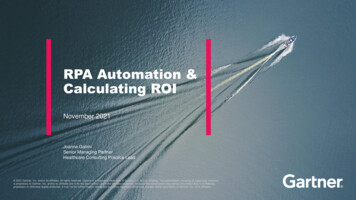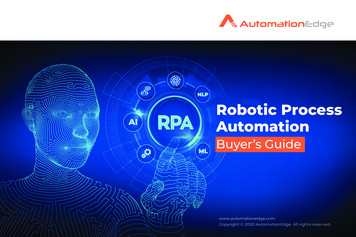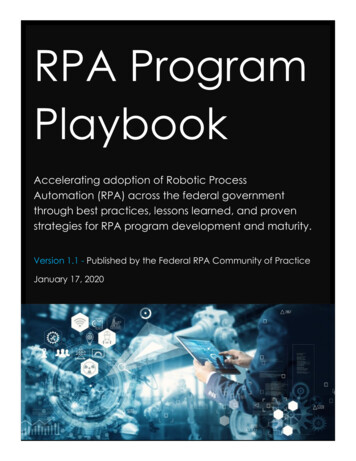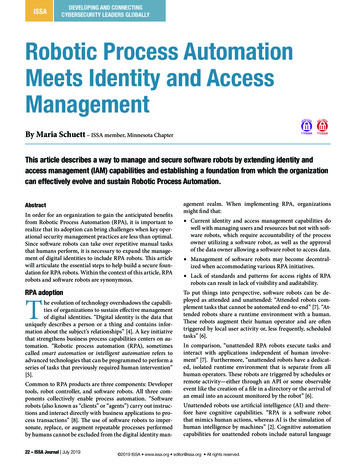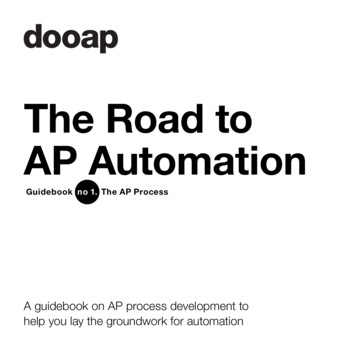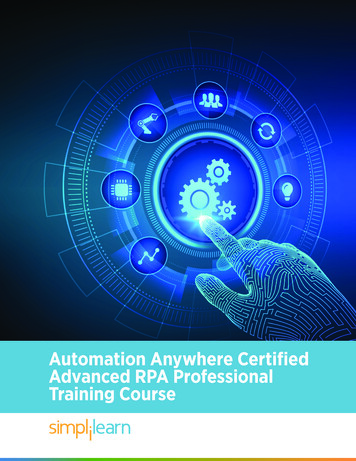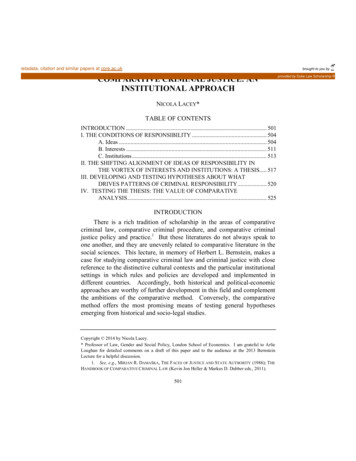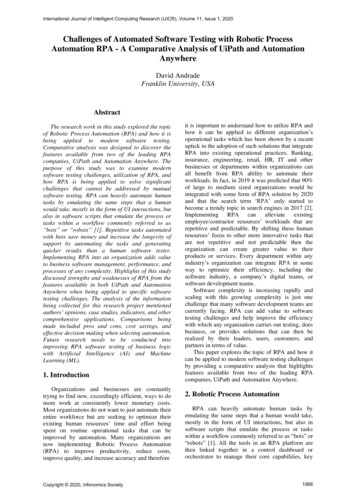
Transcription
Sameera Khan, International Journal of Computer Science and Mobile Applications,Vol.8 Issue. 11, November- 2020, pg. 1-6ISSN: 2321-8363Impact Factor: 5.515COMPARATIVE ANALYSIS OF RPATOOLS-UIPATH, AUTOMATIONANYWHERE AND BLUEPRISMSameera KhanAmity University Chhattisgarh, skhan@rpr.amity.eduDOI: 10.47760/ijcsma.2020.v08i11.001Abstract: Robotic process automation is one of the emerging fields in digital transformation. It is used toautomate the redundant and repetitive task and as a result contributes towards building a large digitalworkforce. It also reduces the use of manpower and time requirement whereas increasing the accuracy andrevenue generation. There are various service platforms which provide tools for robotic process automation.Three major among these are- Automation anywhere, UiPath and BluePrism. These platforms facilitate thedevelopment of software bots which can take up repetitive human tasks. These bots follow defined orrecorded actions to perform the given task in a controlled ecosystem developed by such platform providers.Although RPA is much of a corporate attraction, its academic research background is unexplored. Thispaper presents a comparative analysis of the three platform provider for development of bots to automatebusiness processes.Keywords: Robotic process automation, digital workforce, RPA tools, software bots.1. IntroductionContinuous digital transformations have changed the world to a great extent. Business processes are also notleft untouched with such transformations. One such technology is Robotic Process Automation. According toIEEE Standards Association, Robotic Process Automation is defined as “A preconfigured software instancethat uses business rules and predefined activity choreography to complete the autonomous execution of acombination of processes, activities, transactions, and tasks in one or more unrelated software systems todeliver a result or service with human exception management.” [1] Almost all the industries including humanresources, finance, healthcare, insurance, telecommunication, infrastructure and many more have used RPAtools to automate their business processes. In next decade, almost 50% of such industries plan to automate therepetitive work including front and back office tasks. It is expected that with the introduction of RPA inbusiness processes efficiency, accuracy and speed will increase. On the other hand this will also result inincrease in digital workforce that can eventually cause loss of employment to a certain extent. The basicpurpose of RPA is to automate the recurring tasks in a way humans were doing it with higher accuracy andspeed. RPA affects core business processes immediately in various applications. It will instantaneously affectapplications like employee payroll, employee work status adjustment, new recruitment with different skill set,accounts receivable and payable, invoice and inventory management, software installations and data migrationetc[2].Industry 4.0 revolution has severely impacted the industries. Digitalisation has been an important aspect of thisrevolution. RPA has served as an important technology for this purpose. It can significantly affect theprofitability and degree of competition among the peers [3]. New challenges and opportunities are alwaysassociated with new technologies. If used strategically, RPA can help to manage resources in an efficient wayand it can also result in organizational growth can also be sped up. Robotic Process Automation (RPA) is therule-based automation of business processes by software bots for imitating human behaviour in performing 2020, IJCSMA All Rights Reserved, www.ijcsma.com1
Sameera Khan, International Journal of Computer Science and Mobile Applications,Vol.8 Issue. 11, November- 2020, pg. 1-5ISSN: 2321-8363Impact Factor: 5.515different repetitive tasks, thus helping to reduce tedious work done by employees [4]. RPA is implementedusing software bots also known as artificial intelligence workers. Such AI workers build digital workforce.Data collection and filtering is very repetitive and tedious task. Approximately 17% of the task done by anorganization is data collection, and 16% is data pre processing and filtering [5]. Usually humans undertakethese tasks. Data collection, processing and filtering takes up lots of time and energy of the employees. RPAcan be used to automate these processes which will eventually result in less time consumption and less humanintervention. RPA tools provide a platform to create and deploy such software bots. These bots are capable ofmimicking human actions. With the implementation of RPA in a business process, digital workforce isemployed.RPA can be used to automate variety of tasks like front office task, back office task, end to end processes,sending daily details or updates etc. If such repetitive task is assigned to a digital workforce than humanworkforce can be utilised to do more intelligent and value added tasks. RPA tools provide various methods todesign and deploy such bots. One method is to provide sequence of actions to be performed and another way isto use recorders. Recorders are much easier way of designing a bot and it does not require any programmingknowledge at all. These recorders use components of artificial intelligence to identify parts of task which a userwants to automate. When artificial intelligence is integrated with RPA, it becomes capable of doing human likework with high degree of cognitive capabilities.RPA is capable of addressing various issues at various levels in the organisational hierarchy and at the sametime organisation can face various challenges while employing RPA techniques [3]. Some basic problems andchallenges faced by an institution while employing RPA are - induction of insecurity among workers, fear oflosing confidential information by hacking or by system crash, constant change in the type of work anemployee takes up, proactive planning is needed, overall process must be maintained under human supervisionetc are some to be named. Some of the reasons for organisations to employ RPA to automate their businessprocesses are- to minimise the human errors, maximise the accuracy, minimise the time taken to performrepetitive tasks by human workers, capability to work 24X7, reduction in human workforce and increase indigital workforce, increased capability of handling large data sets etc are a few to be named. Employing RPAfor any business firm gives many advantages [6], a few of them are listed below Accuracy- RPA almost erased typos errors and other human errors and increased accuracy to a veryhigh level. It also maintains uniformity in the data acquisition process. Free of biases- while acquiring data or data filtering no favouritism of biases can hamper work ofRPA. Low Technical Barrier- a person with low technical knowledge or low programming knowledge canconfigure a bot with an ease using RPA development tools Compliance- Bots provide 100% compliance to the given instructions. Also they provide audit trailhistory to analyse the working of a bot. Consistency- Bots can perform same task repetitively for hours or even days with same accuracy andefficiency without getting tired or hampering the performance. Human resource utilization- Man power can be utilised in more fruitful way. Those personnel whowere engaged in doing repetitive tasks can be assigned some more useful tasks. Quality of service- RPA can certainly improve quality of services provided by a business withincreased efficiency and accuracy. Reliability- Bots can apply rules without fail, perform certain tasks without making mistakes and doesnot change course of action in different iterations.Precisely, digital workforce, trustworthy business transformation, better methods of handling voluminous andstructured/unstructured data and return on investment are some of the added advantages of deploying RPA inbusiness processes.2. OverviewWhile deploying RPA technologies to automate business processes, it is very important to select right tasks orprocesse
defined to achieve an exact aim. The three top most RPA tools are UiPath, Automation Anywhere and BluePrism. 2.1 Automation Anywhere Automation anywhere is one of leading service providers among RPA tools. The architecture of AA is client - server based. Three basic components of AA are Bot creator, Control room and Bot runner. Bot creator .


